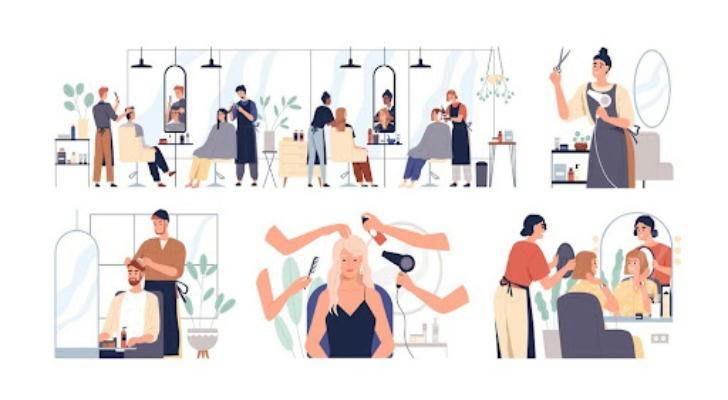Analysis of the career development path of hairdressing: from novice to professional hairstylist
In the United States, the hairdressing industry is not only an important part of the personal care field, but also a career choice full of creativity and interpersonal interaction. Many people regard "hairstylist" as a profession that combines art and skills. It is not only about changing appearance, but also a way to enhance confidence and express personality. Whether you are young, someone who wants to change careers, or someone who loves aesthetics and communication, becoming a professional hairstylist is a career path worth investing in.

Ⅰ. Basic stage: the beginning of learning and training
1. Enroll in compliance courses
The first step to becoming a hairstylist is to enter a licensed hairdressing school (Cosmetology School). Hairdressing courses generally include theoretical learning and practical operation. The course content covers hair design, hair cutting techniques, chemical treatments (such as perming and dyeing), scalp care, hygiene and safety standards, customer service skills, etc.
The course schedule is diverse, which is convenient for people from different backgrounds to choose. For example, some schools offer daytime, evening or weekend courses, which are suitable for working people or people who need to take care of their families.
2. Combination of theory and practice
During the course, students need to master hair structure, dermatology, color science and the use of various products. Most schools have a simulated salon environment on campus, and students will provide basic services to volunteer customers under the guidance of teachers to improve their hands-on ability and customer communication skills.
This stage is not only an important period for skill accumulation, but also a key period to confirm whether you are really suitable for this career.
Ⅱ. Practical accumulation and license acquisition
1. Obtain state license
After completing the course, students need to pass the professional license examination in their state, which is divided into two parts: theory and practice. The theoretical part tests hairdressing-related knowledge and health and safety regulations, and the practical part usually requires on-site demonstration of basic hair cutting, perming, dyeing, and styling operations.
Only after obtaining a license can you be qualified to work legally in hair salons, independent studios, hair care centers, and other places.
2. Entering the workplace and accumulating experience
New hairstylists who enter the industry in the early stage usually start as assistants or junior stylists. Under the guidance of senior hairstylists, they assist in daily work, such as washing hair, blowing hair, preparing dyes, etc. This stage is a key transition period from the classroom to the market. Through continuous learning, observation, and personal operation, service efficiency and professionalism can be improved.
Ⅲ. Career development path: from basic to advanced

1. Diverse career directions
After mastering basic skills and accumulating certain customer resources, hairstylists can choose different development directions according to their interests and expertise, for example:
Haircutting expert: Focus on various haircutting techniques and styling trends
Hair dyeing technician: Proficient in various dyes, bleaching and coloring techniques
Haircare consultant: Good at scalp care and hair repair
Stylist: Focus on activities, weddings, fashion magazine styling design
Educator: Enter hairdressing school to teach, or become a product brand training lecturer
2. Possibility of self-employment
After accumulating certain industry experience and customer reputation, some hairstylists will choose to open a hairdressing studio or rent a salon workstation independently to start the road of self-employment. Although they need to bear more management responsibilities, it also means greater freedom and creative space.
Ⅳ. Case Analysis: From Zero Foundation to Professional Hairstylist
Case: Julia's Hairdressing Journey
Julia is a 30-year-old full-time mother who decided to re-enter the workplace after her child went to school. She has always been interested in hairstyling, so she signed up for evening courses at a local hairdressing school.
Although she was unfamiliar with the use of tools at first, and even the most basic divisions were not accurate enough, she practiced every day and humbly asked teachers and classmates for advice. The simulated salon environment provided by the school gave her the opportunity to serve real customers, which greatly improved her self-confidence.
After graduation, Julia successfully passed the state license exam and found a job in a salon in the community. Three years later, she became the head hairdresser in the store and had a stable customer base on social platforms. She said: "Becoming a hairstylist not only gave me a job, but also helped me regain my sense of value and achievement."

Ⅴ. Continuing Education and Industry Trends
1. A lifelong learning industry
The hairdressing industry is changing rapidly, with new technologies and styles constantly emerging. Professional hairstylists need to keep learning, participate in industry exhibitions, training courses or certification programs, such as trend courses, natural hair care, curly hair cutting skills, new product brand applications, etc.
2. Social media and customer relationship management
Contemporary hairstylists pay more and more attention to online brand building. Showing your portfolio through Instagram, TikTok or Facebook can not only attract new customers, but also help to form a personal brand style. In addition, the reasonable management of the appointment system, customer return visits and service follow-up is also an important strategy to increase the proportion of repeat customers.
VI. Conclusion
Becoming a professional hairstylist is not a one-time thing, but a continuous process from systematic learning, practical training, certification, employment, development, further study to breaking through the self-brand. This career path is suitable for people who love manual skills, are good at communicating with people, and pursue aesthetic expression.
If you are willing to invest time and energy and go through each stage steadily, then hairstylist will not only be a career, but also a bridge for you to realize yourself and achieve your dreams. Whether you are a recent graduate or someone looking for a second career, the hairdressing industry has opened doors full of hope.
